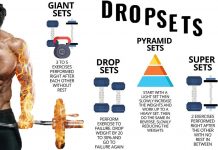🔥 TOP Exercises To Build Big Legs
✅ No matter how great you look from the waist up, neglecting the development of your legs will ultimately make your physique appear weird and unbalanced. Leg training isn’t something that should be saved for “later”, once you accomplish your goal of building a humongous upper body.
[wp_ad_camp_2]

✅ We get it that you probably find it less appealing than for example, biceps training, but the fact remains that if you’re hoping to build a highly aesthetic and well-defined physique, you need to get as serious about building big legs as you are about building a massive chest.
With that in mind, we offer you a set of five must-do leg moves that will push your lower body growth out of the box and separate your physique from that of the average rabid bench presser. Start today!
🚨 Seated Leg Extensions
[wp_ad_camp_4]
The leg extension is a simple, limited movement which occurs only at the knee joint and can be used to strengthen the quads. Leg extensions get a lot of bad rep because there seem to be a lot of guys who believe this is the only move they need to build awesome-looking quads and use it as an excuse to neglect superior exercises like squats and deadlifts.
While it’s true that leg extensions aren’t the greatest leg exercise on the planet, it still has a lot of potential to upgrade your leg development as long as you use it just like you would use any other isolation exercise.
[wp_ad_camp_1]

In this context, leg extensions can and will help you build more muscle, so don’t write them off just yet. In fact, this is a key exercise for strengthening the patellar ligament and the quadriceps attachment for the knee, which is super important for maintaining knee health and improving the results of lower body training.
🚨 Seated Hamstring Curl Technique & Common Mistakes
[wp_ad_camp_5]
Among other things, strong legs require healthy, flexible hamstrings. But let’s be real – the hams are kind of the ugly duckling of the lower body and most athletes have poor hamstring development. And unfortunately, not a lot of them take it seriously, even though weak hams put them at risk of injury and reduce performance quality. A typical lower body training routine will involve heavy work for the quads or glutes, while hamstring-oriented exercises are completely avoided or get put at the end of the line.
This is a mistake for two reasons. First, neglecting the hams will prevent a lifter from utilizing his maximum training potential and second, weak hams are more likely to get injured, especially under heavy loads.

Every guy who has been training for a while has learned that the body works as a system of interconnected links, so when there’s a particularly weak link the overall performance will suffer, and this is very important for both building muscle mass and developing maximum strength. So whenever you choose to avoid training certain body part because it’s difficult or seems unimportant to you at the moment, you’re robbing yourself of a chance to upgrade the performance of the entire system.
[wp_ad_camp_2]
Don’t be one of those guys who only train their favorite muscles – typically, the ones that are the most visible. Instead, improve your routine so that every muscle gets adequate stimuli for strength development and growth.
If you haven’t been training your hams so far, it’s time to give them some love. Read the rest of this article to learn where to start!

🚨 Hamstring Anatomy & Function
Although these muscles are far from the most impressive-looking ones in the human body, there’s no denying that they’re key to pezrformance and functionality. If your hams are weak and tight, they’re vulnerable to strain and may tear during strenuous exercise.
[wp_ad_camp_3]
The hamstring is actually comprised of three muscles: the semitendinosus, semimembranosus and biceps femoris, which are responsible for knee flexion and stabilization and hip extension. Together with the glutes and calves, the hamstring creates the posterior chain of the leg and contributes to almost all lower body movements, such as walking, running, climbing and squatting, as well as providing muscular stability and symmetry. This makes the hamstrings one of the key “speed muscles” in the body which enable us to run fast, which is why they tend to be more fast-twitch dominant that other muscle groups.
















































